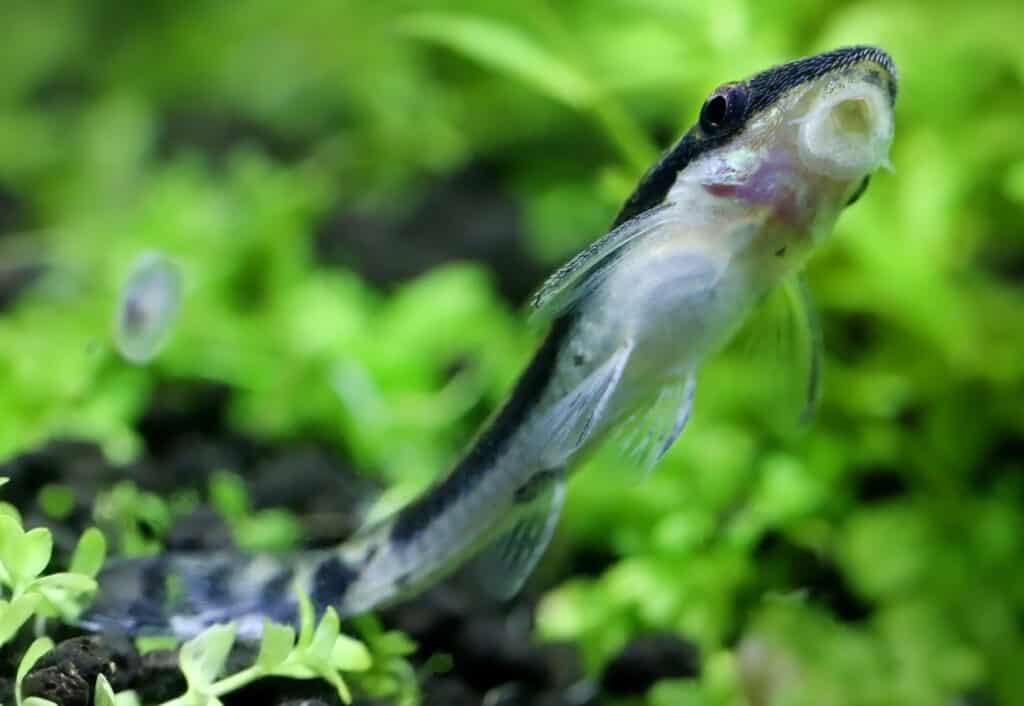
When choosing the aquatic life to put in a fish tank, a lot of choices involve species that are showpieces, or schooling fish that add movement and excitement to a tank.
There is then a time when a cleanup crew, typically bottom dwellers are thought of, and the tried and true usually involve Snails or Shrimp.
But are there other options that can provide the same benefits?
Today we are going to explore some alternatives to Snails and Shrimp, as well as what to look for when choosing to gain the same benefits that snails and shrimp provide.
Snail and Shrimp Alternatives

Corydoras Catfish
Corydoras, or Cory for short encompasses a wide variety of species that vary in shape, size, color, and even patterns.
They eat by sifting the substrate through their mouths looking for particles of food. For that reason, these fish are recommended for tanks with sandy substrate.
They are also shoaling fish that enjoy being in groups as they roam the bottom of their tank.
Though they are not algae eaters, Cory Catfish help aerate the substrate because of how they eat and are excellent scavengers that will take care of uneaten food
Some popular subspecies include the Sterbai Cory, Julli Cory, Peppered Cory, Panda Cory, and Bronze Cory.

Kuhli Loaches
This fish is an oddball for freshwater tanks, because of its unique elongated body.
They are known as fantastic cleaner fish that will scavenge for food to help clean up any leftover food in the tank.
The Kuhli Loach will be found burrowing in the ground.
This will provide aeration for the substrate, while also bringing up loose food and other particles up to the top of the substrate to be able to clean out.

Otocinclus Catfish
If looking for an alternative fish that provides the same algae-eating benefits as snails and shrimp, then this could be a perfect option.
Otocinclus Catfish are known for their love of eating algae off of plants, and surfaces of the tank. Helping to keep the tank and water clean.
Since they are smaller in size, they even make great additions to nano tanks, providing an alternative option to shrimp for keeping the algae in check in smaller tanks.
Bristlenose Plecos
Another fish that will provide a similar unique visual appeal to shrimp and snails is the Bristlenose Pleco. They will normally be either brown, green, or gray with yellow or white spots along their body. Their name comes from the unique tentacles around the mouth that are used to detect the nose. Coming in on the larger side compared to these other options, they will typically grow to around 5 inches in length. But they also provide great algae control, as they will eat almost any type of algae. They are also the only fish on this list that can be happy being the only species, not requiring multiple plecos to thrive.
What Snails and Shrimp Can Provide A Tank
Scavenging, aerating substrate, location, unique appearance/aesthetic
There are several things that snails and shrimp can provide your tank, that you might want to consider and look for in their replacements.
A certain appeal for snails and shrimp comes from their unique appearance which brings a different aesthetic to a tank.
Nothing else really will look like either of these creatures, so they are often chosen because they will stand out from other species in a tank.
So maybe consider getting a fish that has special physical features like a Kuli loach, or a bristlenose plecos. With the loach its shape, and the bristlenose facial features they will stand out from the rest of the tank inhabitants.
Not only the visual appeal should be considered though. Snails and Shrimp can also provide overall ecosystem benefits, as they feed on leftover food, help control algae, and aerate the substrate.
They also help fill out the bottom of a tank. When looking for a visually harmonious tank. The swimming levels should be considered for different tank inhabitants. So if there’s a desire to have species that are not snails or shrimp, choices should probably be limited to bottom dwellers or species that enjoy living and swimming at the bottom of the tank.
Most bottom dwellers will also provide similar benefits to the snails and shrimp as a lot of them have somewhat scavenger tendencies, and will normally sift the substrate for food providing aeration.
Why Consider Alternatives to Snails and Shrimp
A very common reason to consider alternatives is for the compatibility between other species. If for instance there is a betta fish, angelfish, or other larger fish, they will at the very least pick on the shrimp, or eat them. A general rule is that if a fish can fit it in their mouth, they will attempt to eat it.
In these cases shrimp would be hard to keep since their offspring, as well as the adults would be targeted continuously.
This can be the same case for snails, though maybe not small enough to be preyed on, larger fish, or smaller nippy fish may go after the snails and their feelers causing stress.
These problems can be alleviated with alternative options that are either larger or can swim away from any problems that snails and shrimp just don’t possess.
Snails and shrimp can also have explosive population growth that can sometimes be hard to manage. Though population growth can occur with different options, they will in most cases not be as near prolific in the quickness of growth.
Final Thoughts
Though Shrimp and Snails are worth the consideration for your tank, several situations, and preferences can lead someone in another direction.
If considering possible alternatives, remember to understand what you are trying to replace, in appearances, and benefits brought to your tank to find the perfect shrimp and snail replacement.
